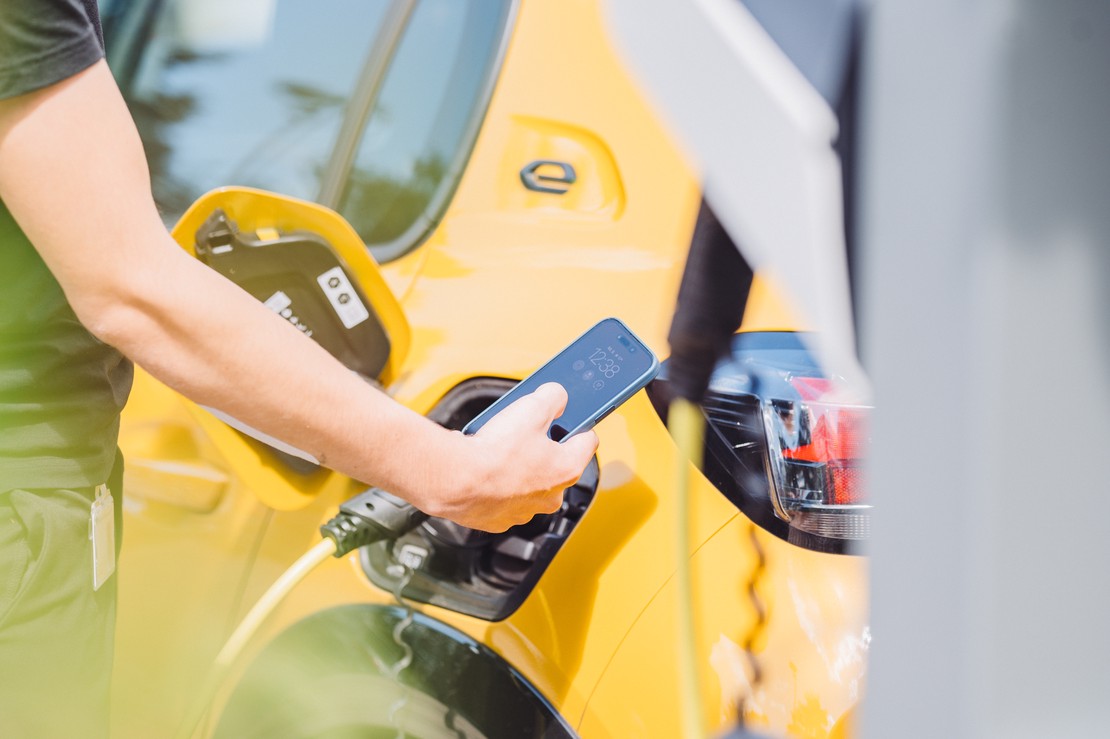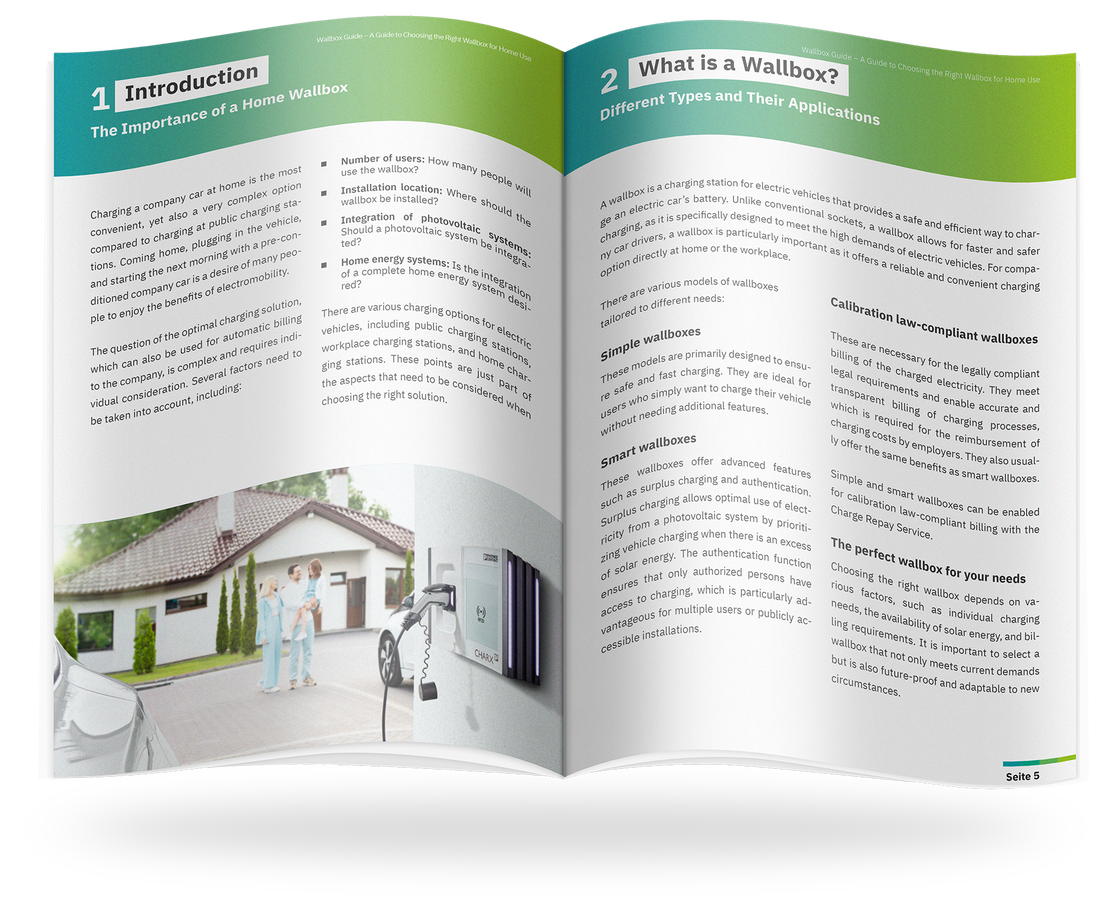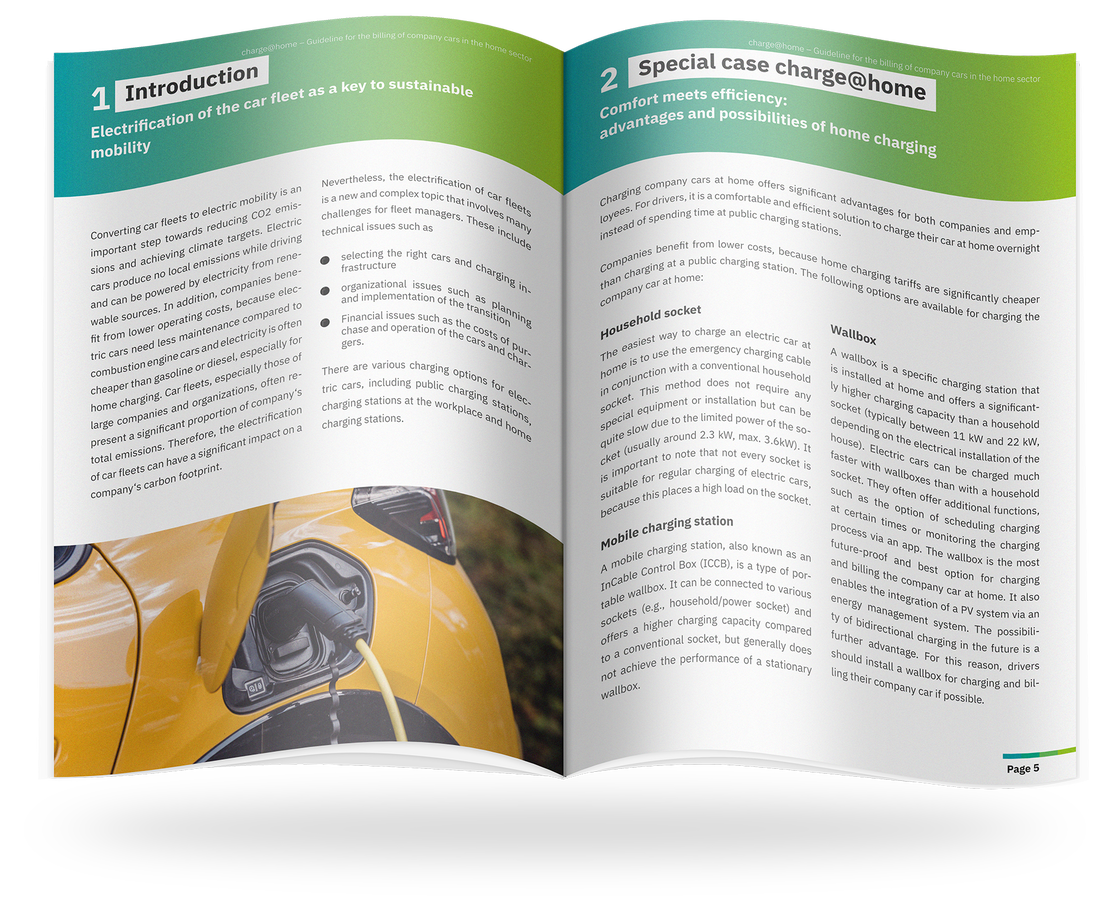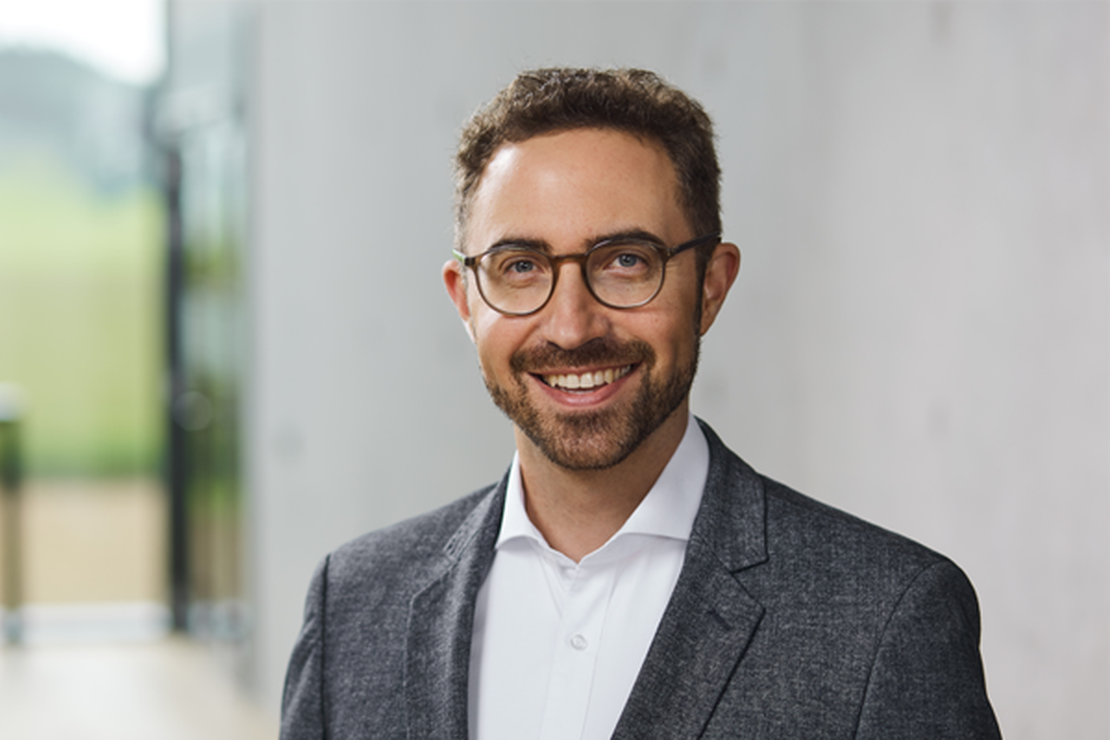This article provides an overview of possible approaches to billing home charging sessions. It does not constitute legal or tax advice. Please consult a qualified professional if you require specific guidance.
Easy Billing: Overview of Models
More and more companies are turning to electromobility and offering their employees electric company cars. But how does charging and billing for home charging work ? Here are the most important information and options:
Only valid until December 31, 2025: Flat Rate Instead of Calculation Stress
Note: According to the Federal Ministry of Finance, this regulation is only valid until December 31, 2025. Starting January 1, 2026, the option to reimburse charging costs via flat rates will no longer apply. Instead, the electricity price allowance will be introduced. Here you can find the official information from the BMF: Click here for the official letter .
A simple option is for the company to pay a monthly flat rate. This flat rate can vary depending on the type of vehicle and the availability of a charging option at the workplace. For electric cars, the flat rate is, for example, 70 euros per month (in germany) if there is no charging option at the workplace. However, if a company-owned charging option is available, the flat rate can be reduced to 30 euros per month. For plug-in hybrid vehicles, the flat rate is 35 euros per month without a charging option at the workplace and 15 euros if a charging option is available.
This method is practical because it requires little administrative effort and provides a simple solution for both parties. The employer can reimburse the flat rate tax-free, which is beneficial for both the company and the employee. Additionally, this regulation promotes the use of electric vehicles and contributes to the reduction of CO2 emissions.
However, it is not guaranteed that the company car driver will use this flat rate and charge their electric company car at home. There is a possibility that the employee will receive the flat rate but still prefer other charging options. To avoid this, companies could create additional incentives, such as providing wall boxes for home charging or setting up charging points at the workplace.

New from 2026: Electricity Price Allowance
Starting January 1, 2026, the option to reimburse charging costs via monthly flat rates will no longer apply. As a replacement, the electricity price allowance offers a simple and tax-compliant solution. The calculation is based on the average household electricity price in the first half of the previous year, published by the Federal Statistical Office (Destatis). For 2026, this value is around €0.34/kWh. Companies multiply this price by the verified amount of electricity consumed, resulting in a transparent and tax-free reimbursement. The electricity price allowance applies from 2026 to 2030 and requires proof of the charged kilowatt-hours. This proof can be provided via a stationary meter, a mobile meter, or the vehicle’s internal electricity meter. The requirements of the AGME remain in effect. This method combines easy calculation with tax security and is particularly suitable for companies that prefer a straightforward solution.

Accurate Manual Billing by Kilowatt Hours
A more precise method is billing for the actual kilowatt hours charged. For this, the power consumption must be accurately recorded, which can be done using a separate electricity meter or an appropriate wallbox. The company then reimburses the electricity costs as a tax-free expense reimbursement. This method has the advantage of accurately reflecting the actual costs but requires precise documentation and possibly additional technical equipment.
In this case, recording and billing are done manually. The employee notes the power consumption themselves, for example, by regularly reading an intermediate meter or the wallbox. The collected data is then submitted to the employer for reimbursement. This method requires a bit more effort and discipline in documentation but offers a flexible and cost-effective solution, especially if no technical means for automatic recording are available. With manual billing, the actual power consumption can be accurately recorded, and the costs billed accordingly.
Processing manual receipts usually generates high costs and is prone to errors, making the limited resources in fleet management inefficiently used. Therefore, regularly occurring business transactions should ideally be processed automatically.
Automatic Recording and Billing
Another option, preferred by many, is using an automatic billing model. In this case, a legally compliant wallbox with a connection to a billing backend is usually installed at the company car driver’s home by a billing provider. To charge the company car, the driver authenticates themselves using RFID, and the charging processes are automatically transmitted to the company and billed. Many billing providers restrict the selection of wallboxes that can be installed to certain models they have selected.
With Phoenix Contact ’s Charge Repay Service, you can precisely and efficiently bill the kilowatt hours charged for your company vehicles. This service enables transparent and accurate recording of charging processes, regardless of the wallbox used. This simplifies billing for both employers and employees.

Home Power: Your Own Wallbox
Your Personal Charging Station
Many employees charge their company cars at a private wallbox. This can either be provided by the company or purchased by the employee. A wallbox allows for fast and safe charging and can be equipped with a MID-certified meter to measure the exact power consumption. A wallbox also offers the advantage of often charging faster than a conventional socket and providing additional safety features.
To ensure that the electricity costs for charging company cars are correctly billed between the company and employees, the wallbox used must meet certain requirements.
Legal Compliance in Germany: An important aspect of charging company cars at home is the legal compliance of the wallbox used. This ensures that the measured power quantities are accurately and tamper-proof recorded. Wallboxes that are legally compliant have calibrated meters that meet the requirements of the German Measurement and Calibration Act (MessEG) and the Measurement and Calibration Ordinance (MessEV). Application regulations are provided by the REA 6-A document of the AGME (Working Group on Measurement and Calibration). A consortium of the 16 German calibration authorities that define the application areas of electromobility and the applicable standards. Therefore, the company and employees should ensure that the installed wallbox meets these requirements to ensure correct and legally compliant billing.
In our blog post “Legally Compliant Charging at Home ” we have outlined all the important information on this topic.
RFID-Based Access Protection: To ensure that only authorized persons can use the wallbox, RFID-based access protection is essential. This technology allows the wallbox to be released only for registered users. The RFID chip or RFID card is simply held to the wallbox, and the charging process starts only if the card is authorized. This prevents unauthorized use and ensures that the billing of electricity costs is accurate. Especially in shared parking lots or freely accessible driveways, RFID access protection offers a reliable solution to accurately control and document power consumption.
Feel free to read our blog post on this topic: RFID Technology in the Home Environment .
Note on Technical Requirements: As of January 1, 2024, new regulations under § 14a of the German Energy Industry Act (EnWG) apply to the installation of controllable consumption devices such as wallboxes. These devices must be capable of being throttled to a power output of 4.2 kW by the grid operator, when necessary, in order to maintain grid stability. For companies and private individuals installing a new wallbox, this may lead to reduced grid fees. It is therefore advisable to choose a wallbox that complies with the controllability requirements of § 14a EnWG and to coordinate with the relevant grid operator in advance.
Practical Installation Tips: Please note that the installation of a new wallbox usually needs to be reported to the responsible grid operator. This is particularly important to ensure grid stability and to meet the requirements of § 14a EnWG. Before installation, coordinate with your grid operator to clarify technical specifications, potential throttling, and available subsidies. Additional information can be found in our blog post: Standards-Compliant Installation of a Wallbox .
Billing for Shared Wallboxes: In apartment buildings or shared parking areas, a wallbox may be used by multiple users. For accurate and transparent billing, it is recommended to use wallboxes with user-specific consumption tracking, such as via RFID access or individual user profiles. This allows electricity usage to be clearly attributed to each person and billed accordingly. Learn more in our blog post: Wallbox Billing for Multiple Users .
Further information on the criteria for selecting the right wallbox can be found in our Wallbox Guide.
Guide to choosing a Wallbox: Your comprehensive Guide!
Our guide provides you with important insights into the details you should consider before purchasing a wallbox. Learn about the key criteria to make the right choice for your home and company car.
REQUEST GUIDE
Easy Charging on the Go
Additionally, employers can provide charging cards that allow employees to charge at public charging stations. This is particularly convenient for on-the-go and offers flexibility when there is no home charging option available. Public charging stations are often found in strategically convenient locations such as shopping centers, parking garages, or highway rest stops.
Who Pays for the Wallbox for the Company Car?
In practice, two options for purchasing the wallbox have proven successful:
- Purchase by Employees: The company lets the employees buy the wallbox themselves, thereby avoiding liability risks for the company. It is important to work with a mobility service provider that offers high flexibility in wallbox models so that the employee can choose freely. The incurred costs can be reimbursed through the travel expense report, or the company pays a flat-rate subsidy for the wallbox.
- Company Purchase and Rental: The company takes over the purchase and installation of the wallbox and then rents it to the employee. In this case, the company can set better specifications for the wallbox model but has additional administrative efforts due to the rental of the hardware. It should be noted that this could lead to lower acceptance among company car drivers if the employer prescribes a specific wallbox model.
Tax Benefits and Subsidies in Germany: What You Should Know
Utilize Tax Benefits
Charging a company car at home can offer tax benefits. The benefits granted by the employer for the temporary private use of a company-provided charging facility for electric or hybrid electric vehicles are tax-free according to § 3 No. 46 EStG. Additionally, companies can claim the costs for the charging electricity as business expenses, providing additional tax relief.
In our blog post, you can read everything you need to know about the tax benefits of electric company cars in Germany .
Utilize Subsidies
Currently, there is no nationwide funding for private wallboxes available: The previous KfW funding programs – most recently program 442 “Solar Power for Electric Cars” – were discontinued in 2023. A new edition at the federal level is currently not planned.
Regional funding opportunities still exist: Some federal states, municipalities, and energy suppliers continue to offer regional funding programs for the purchase and installation of charging stations.
Recommendation: It is worth regularly checking the websites of local energy suppliers, municipal utilities, or funding agencies. Many programs are subject to certain conditions, such as the use of green electricity tariffs or technical standards. Important: The application usually has to be submitted before purchase.
Funding Opportunities for Companies
Even though nationwide funding programs for private wallboxes are currently not available, attractive funding opportunities for companies still exist. These are aimed particularly at businesses that want to set up charging infrastructure for employees or their own fleet. Programs such as progres.nrw in North Rhine-Westphalia or municipal initiatives in cities like Munich, Hamburg, or Stuttgart support the installation of charging points on employee parking lots, the integration of photovoltaic systems, and the purchase of load management systems. The amount of funding and requirements vary depending on the federal state and municipality. It is advisable to regularly check the websites of the respective state development banks, municipal utilities, or energy agencies. Companies benefit not only from financial subsidies but also from tax advantages and an improved CO₂ balance.
THG Quota as an Additional Source of Income
In addition to funding programs, the so-called THG quota (Greenhouse Gas Reduction Quota) offers an attractive refinancing option for owners of electric vehicles. The CO₂ emissions saved by operating an electric vehicle can be sold annually to certified providers. Charging at home is also taken into account, provided the vehicle is registered to the employee or the company. Payment is usually made once a year and can amount to several hundred euros depending on the provider and market price. Companies with electrified fleets can market the THG quota collectively and thus generate additional income. It is advisable to compare the offers of various THG quota brokers and pay attention to transparent billing models.
Download our charge@home Guide now!
Our guide highlights the requirements for a home charging solution and explains what is needed to use it for legally compliant billing of company cars. Learn more about the installation of wallboxes, legal frameworks, and efficient billing solutions for home charging.
REQUEST GUIDE
More to Know
New Regulation for Electric Company Cars: Since July 1, 2025, an extended tax benefit applies to the private use of electric company cars. The taxable benefit continues to be taxed at only 0.25% of the gross list price – now up to a list price of 100,000 EUR. This increase in the price limit replaces the previous limit of 70,000 EUR and makes higher-value electric vehicles tax-attractive. For vehicles with a gross list price over 100,000 EUR, the 0.5% rule applies. The regulation applies to all pure electric and fuel cell vehicles newly registered from July 1, 2025.
Tax-Free Charging Options at the Employer: The free or discounted charging of electric or hybrid vehicles at the employer’s premises is tax-free if the company provides the service in addition to the salary owed anyway. This also applies to temporary workers. This regulation offers an attractive way to promote the use of electric vehicles while also taking advantage of tax benefits.
Charging and Billing at Home with the Charge Repay Service
The Charge Repay Service offers a convenient and efficient solution for charging and billing company cars at home. Here are some of the benefits:
- Automated Billing: The Charge Repay Service records billing-relevant data from home wallboxes and enables kilowatt-hour accurate billing of home charging processes for the electric company car. This saves time and reduces administrative effort for both employers and employees.
- Easy Integration: Regardless of the wallbox used, legally compliant billing is possible. Existing systems do not need to be replaced but can be easily integrated. This offers flexibility and allows seamless integration into existing infrastructures.
- Certified Installation Service: The service works nationwide with certified electrical installation specialists and guarantees a safe, compliant, and timely installation of the hardware. This ensures that all technical and legal requirements are met and the installation runs smoothly.
- Data Protection and Flexibility: The sensitive data of company car drivers remain protected, and payments can be made directly through the Charge Repay Service. This ensures high data security while offering flexibility in billing.
The Charge Repay Service has made my experience with the electric company car noticeably more attractive: Without retrofitting an expensive wallbox, I can now charge at home and have the costs billed easily and without major effort for my company. As a friend and advocate of sustainable digitization, I am honestly enthusiastic about this solution!

Conclusion: Efficient Charging and Billing
Charging and billing company cars at home can be simple and efficient when the right methods and technologies are used. Whether through the electricity price allowance, manual billing, or automatic recording of charged kilowatt-hours – there is a suitable solution for every company and employee. The Charge Repay Service from Phoenix Contact, in particular, offers a flexible and user-friendly way to automate and simplify billing, regardless of the wallbox used. With the right technical prerequisites and a clear billing strategy, companies and employees can not only promote electromobility but also benefit from tax advantages and subsidies. This makes charging company cars at home a convenient and cost-effective solution for all parties involved.
